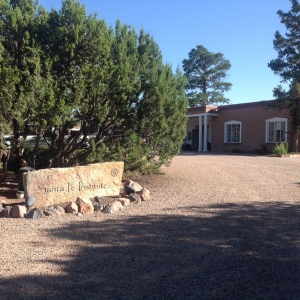The science and engineering of biological computation: from process to software to DNA-based neural networks
September 21, 2019 1 Comment
In the earlier days of TheEGG, I used to write extensively about the themes of some of the smaller conferences and workshops that I attended. One of the first such workshops I blogged about in detail was the 2nd workshop on Natural Algorithms and the Sciences in May 2013. That spawned an eight post series that I closed with a vision for a path toward an algorithmic theory of biology. In the six years since, I’ve been following that path. But I have fallen out of the habit of writing summary posts about the workshops that I attend.
 Since my recent trip to the Santa Fe Institute for the “What is biological computation?” workshop (11 – 13 September 2019) brought me full circle in thinking about algorithmic biology, I thought I’d rekindle the habit of post-workshop blogging. During this SFI workshop — unlike the 2013 workshop in Princeton — I was live tweeting. So if you prefer my completely raw, unedited impressions in tweet form then you can take a look at those threads for Wednesday (14 tweets), Thursday (15 tweets), and Friday (31 tweets). Last week, I wrote about the first day (Wednesday): Elements of biological computation & stochastic thermodynamics of life.
Since my recent trip to the Santa Fe Institute for the “What is biological computation?” workshop (11 – 13 September 2019) brought me full circle in thinking about algorithmic biology, I thought I’d rekindle the habit of post-workshop blogging. During this SFI workshop — unlike the 2013 workshop in Princeton — I was live tweeting. So if you prefer my completely raw, unedited impressions in tweet form then you can take a look at those threads for Wednesday (14 tweets), Thursday (15 tweets), and Friday (31 tweets). Last week, I wrote about the first day (Wednesday): Elements of biological computation & stochastic thermodynamics of life.
This week, I want to go through the shorter second day and the presentations by Luca Cardelli, Stephanie Forrest, and Lulu Qian.
As before, it is also important to note that this is the workshop through my eyes. So this retelling is subject to the limits of my understanding, notes, and recollection. And as I procrastinate more and more on writing up the story, that recollection becomes less and less accurate.
 This week, I was visiting the Santa Fe Institute for a workshop organized by Albert Kao, Jessica Flack, and David Wolpert on “
This week, I was visiting the Santa Fe Institute for a workshop organized by Albert Kao, Jessica Flack, and David Wolpert on “


Principles of biological computation: from circadian clock to evolution
September 28, 2019 by Artem Kaznatcheev Leave a comment
If you prefer my completely raw, unedited impressions in a series of chronological tweets, then you can look at the threads for the three days: Wednesday (14 tweets), Thursday (15 tweets), and Friday (31 tweets).
As before, it is important to note that this is the workshop through my eyes. So this retelling is subject to the limits of my understanding, notes, and recollection. This is especially distorting for this final day given the large number of 10 minute talks.
Read more of this post
Filed under Commentary, Preliminary Tagged with algorithmic philosophy, conference